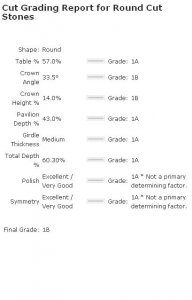I am quite confused by the question.
According to the specifications of one laboratory, "Tolkowsky Range" is as follows:
53 - 57% Table based on diamond''s overall diameter.
33 - 36¡ã Crown Angle.
40 - 41.5¡ã Pavilion Angles.
56 - 60.5% Total Depth (excluding girdle thickness) with 14 - 16.5% of the depth being comprised of the crown (top half of the diamond) and 42 - 44% representing the pavilion lower half of the diamond.
But A true "Ideal Cut Diamond" is a round brilliant cut diamond that has been cut to AGS Ideal Cut Proportions as defined in the following table:
Table Diameter 52.4 - 57.5%
Crown Angle 33.7 - 35.8¡ã
Pavilion Angle 40.2 - 41.2¡ã
Girdle Thickness Thin, Medium, Slightly Thick
Culet Size None, Pointed, Very Small, Small, Medium
Now, there is a stone I am going to buy with the following proportions, which is unfortunately falling out of AGS Ideal Range.
Depth: 60.3%
Table: 57%
Crown Angle: 33.5
Pavilion Angle: 40.8
Culet: 0
Girdle: Medium, Facted (3.0%)
My question is: Why is that? Will it affect the future value of the stone?
Thanks.
According to the specifications of one laboratory, "Tolkowsky Range" is as follows:
53 - 57% Table based on diamond''s overall diameter.
33 - 36¡ã Crown Angle.
40 - 41.5¡ã Pavilion Angles.
56 - 60.5% Total Depth (excluding girdle thickness) with 14 - 16.5% of the depth being comprised of the crown (top half of the diamond) and 42 - 44% representing the pavilion lower half of the diamond.
But A true "Ideal Cut Diamond" is a round brilliant cut diamond that has been cut to AGS Ideal Cut Proportions as defined in the following table:
Table Diameter 52.4 - 57.5%
Crown Angle 33.7 - 35.8¡ã
Pavilion Angle 40.2 - 41.2¡ã
Girdle Thickness Thin, Medium, Slightly Thick
Culet Size None, Pointed, Very Small, Small, Medium
Now, there is a stone I am going to buy with the following proportions, which is unfortunately falling out of AGS Ideal Range.
Depth: 60.3%
Table: 57%
Crown Angle: 33.5
Pavilion Angle: 40.8
Culet: 0
Girdle: Medium, Facted (3.0%)
My question is: Why is that? Will it affect the future value of the stone?
Thanks.










300x240.png)